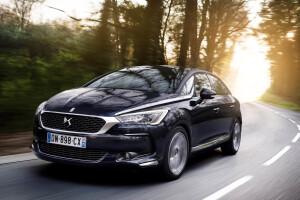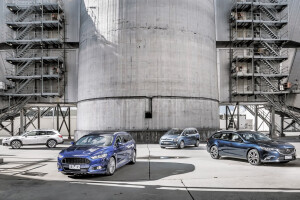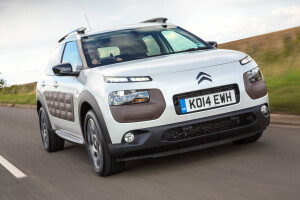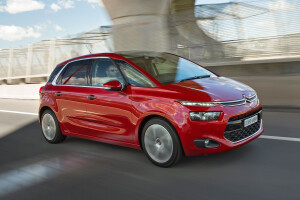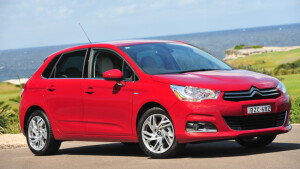Latest Review

2022 Citroën C4 review
Out-there styling and supreme comfort make the Citroen C4 surprisingly loveable, but Aussies will still need a lot of persuading…
The new 2022 Citroën C4 is a quirky little thing. Out-there styling and supreme comfort make it surprisingly loveable – and it’s also got us feeling all nostalgic.
This writer’s first proper car was a nippy 1.6-litre 1997 Citroën Saxo, which is perhaps why we’ve found a surprising degree of fondness for this new model.
But selling this unique crossover in Australia is going to need Gallic charm in spades if it is to win over the market. With Citroën having sold just 175 cars from its three-strong line-up during the first 11 months of 2021, it needs to find new ways to cut it on an increasingly competitive playing field.
On test here is the near-top-spec Shine trim with front-wheel drive and 1.2-litre three-cylinder turbo-petrol engine – the only variant currently on offer in Australia – sporting optional metallic Pulse Orange paint and a glass sunroof.
Pricing
While the new C4’s looks are certainly capable of turning heads (it’s not quite as tall as a standard SUV but still more elevated than a standard hatch, so instantly stands out from the crowd), its price is likely to raise a few eyebrows, too.
While other markets get four variants, three of which are electric, Australia gets just one – the Shine variant that costs $37,990 before options and on-road costs. It’s worth noting, however, that Citroën’s local boss recently confirmed the e-C4 is currently under evaluation for Australia, so we may yet see another version land here in the future.
Throw in on-roads, another $690 for one of six optional metallic paint colours (only white is standard) and an extra $1490 on top of that for a sunroof, and the sticker price for the car we have here quickly breaks the $40K mark – coming in at $44,669 drive-away.
Whether or not it presents good value really depends on if you consider it a light SUV (typically crossovers) or a small one (which it is officially classified as by VFACTS). Even at launch, Citroën was not able to nail which category the new C4 truly falls into. It is trying to appeal to anyone and everyone, but in reality it just feels like it doesn’t quite know what it wants to be.
Top-spec light SUV rivals such as the Mazda CX-3 Akari LE Auto and Ford Puma ST-Line will set you back $38,990 and $39,944 drive-away respectively, minus any options, while the Toyota Yaris Cross Urban’s drive-away price, without any extras, is $39,169.
Small SUV competitors meanwhile, such as the Mazda CX-30 G20 Touring, Toyota C-HR Koba and Subaru XV 2.0i-S, come in at $40,772, $39,452 (or $41,953 as a hybrid) and $41,844 drive-away respectively.
Design
The French don’t believe in playing safe with their design, and the new C4 is no exception. Its fresh, modern and funky looks set it apart from the pack, combining elements of its former hatchback self with the higher ride of an SUV. The vibrant orange paint of this test car really shows its individuality too – this is no Russian doll design.
Influenced by the CXPerience, Ami One and 19_19 concept cars, the C4’s design uses Citroën's front-end signature with double-stage headlights and chrome chevrons stretched across the front of the car, extending upwards to the daytime running lights and down to the headlights.
A high, horizontal bonnet line gives the new C4 a more robust appearance than in previous generations, and is underscored by a front bumper using a matte black lower skirt for durability and ’this is an SUV’ box-ticking, though a body-coloured one would look sleeker. The air intake grilles use the macro chevron pattern first seen on the recent concepts.
The matte black wheel arches are linked to the front and rear bumper skirts and signature ‘Airbump’ that’s said to highlight the body shape while also reportedly provide protection. It’s far more toned down here than we’ve seen previously with the C4 Cactus; in fact you’d be hard-pushed to notice it at all.
Its roofline, combined with the sloping rear window and glazed sunroof (if optioned) look the part, but what the prominent rear spoiler adds to the new C4’s aerodynamics, it takes away from visibility. The rear window is small to begin with, but add a spoiler and one (or two) of the rear headrests forced upwards to accommodate the top of a child seat and suddenly you’re squinting through a gap the size of a letterbox.
The French don’t believe in playing safe with their design, and the new C4 is no exception to that rule. Its fresh, modern and funky looks set it apart from the pack
The rear-end design is said to have been inspired by the 2004 C4 Coupe, while the V-shaped LED rear lighting signature is also borrowed from the Ami One and 19_19. Mirroring the frontal design, its tail-lights are linked by a glossy black strip giving it a clean and polished appearance.
The bumper skirt – again matte black – has a gloss black trim surround for the chrome exhaust tips, while two outer air scoops are connected by a styling line on the hatch.
Finishing the C4’s look are 18-inch Aeroblade alloy wheels shod in 195/60 R18 rubber.
On the inside, the new C4 sports a grippy – yet soft – deluxe leather steering wheel and light grey chevron-patterned stripes across the front seats and door cards, which look attractive.
The seats are trimmed in black Siena leather with Zephyr grey stitching and complement the piano black gloss centre console – though like any car with this interior trim, it gets dirty and smudged easily through constant touching.
The armrest is clad in padded leather too, which looks and feels of good quality, though there are also an array of hard plastics on show, which remind you that while this little funky French car may be jazzy, it’s not a premium offering.
Features
The C4 has a raft of features that make it an enjoyable place to spend your time on either long or short trips, such as: Two USB-C and USB-A ports (one of each, though Apple Car Play only works using a USB-C cable, which took us longer to figure out than we care to admit), a 12V power outlet and reversing camera with top-down 360-degree view – as well as sensors to making parking easier.
One very distinctive feature we’ve not seen elsewhere before is a dedicated stand and tray embedded in the dash on the front passenger’s side, which can hold a 10.5-inch-sized device or smaller, such as an iPad Air 2 or Galaxy Tab A. A larger stand can be purchased for bigger tablets.
It’s a pretty cool piece of kit on the face of it, especially since the specially-developed cover stops it from being visible from the driver’s side, though such a tool would perhaps be better suited to the second row to keep kids entertained – as we can’t imagine it getting much use by an adult on a regular basis and it can restrict front-seat space for taller passengers.
However, what lets the C4 down is the infotainment system – which can also be found throughout the Peugeot-Citroën car family.
This is one of those times where you thank your lucky stars for Apple CarPlay or Android Auto (which the C4 does have, just not wireless). This unit seems overly complicated, doesn’t look particularly nice (even at maximum brightness it is dull), and lacks functionality.
The system, operated through the 10-inch central touchscreen, doesn’t have a main menu and you can’t easily listen to the radio if your phone is plugged in (because it defaults to your music app) without using the voice command function or a lot of jiggery pokery, which is a pain.
But the 5.5-inch digital instrument cluster couldn’t be more different. Unlike many cars these days, where so much information is crammed into a small space that you can get any metric you could ever want at the click of a button, Citroën has stripped all that out and kept things simple, which is actually very refreshing. It’s amazing what you don’t miss when it’s gone.
The head-up display is a nice addition too – although it’s worth noting that the speed sign recognition shown on it often struggles to know what the limit is, and can’t cope with stretches where this varies continuously.
One very distinctive feature we’ve not seen elsewhere before is a dedicated stand embedded in the dash, which can hold an iPad
Funny logic can also be found in the location of the door unlock button – it is nestled snugly under the hazard light trigger in the middle of the dash, which seems the oddest of places given almost every other car has it on the driver’s door. Go figure.
Second-row occupants get rear centre console air vents and two USB ports (one A and one C) as well as a cup holder in each door and two when the middle seat folds down into an armrest – though none are large enough to accommodate a one-litre drink bottle.
Comfort and space
If there’s one thing the C4 does really well – it’s comfort.
Its supremely plush memory foam ‘Advanced Comfort’ seats, coupled with cushiony suspension – thanks to dual-stage hydraulic dampers – make it more like driving on air than on a road. We’ll tell you more about that later.
Being a high-spec variant, it has a wealth of creature comforts on-board too, including heated front seats that have four-way electrical adjustment (though oddly still has the old-fashioned manual bar underneath for sliding forwards or backwards), and a basic one-setting massage function for the driver’s side.
Though it pleasingly has privacy glass at the rear as standard, the tint is a little weak compared to many vehicles, and to feel truly comfortable that little ones are shielded from harsh UV rays on bright days you might want to consider a window sock – even if it would somewhat detract from the fun and edgy look the C4 is going for.
As for space, the crossover C4 is surprisingly roomy. On paper, it’s 4355mm long, 2032mm wide, 1525mm high and has a 2670mm wheelbase.
In fact it’s like a Tardis (bigger on the inside) than it appears from first impressions.
There’s plenty of space in both the first and second rows – with ‘class-leading’ legroom in the back, according to Citroën
There’s plenty of space in both the first and second rows – with a ‘class-leading’ 198mm of legroom in the back, according to Citroën. It’s certainly enough for kiddos to spend a short or long journey in comfortably, and even for an average-sized adult.
The boot is sizeable for a small-ish car too. In addition to multiple pockets of space littered throughout the cabin, there’s 380L on offer with the seats up or 1250L with the second row folded down.
The one slight disappointment here is that it misses out on a powered tailgate, and in this case, that means it is heavy and hard to close with just one hand on the go. Given that the C4 gets heated and powered wing mirrors, it’s a feature we’re surprised has been missed off the equipment list.
On the road
The C4 has a punchy 1.2-litre three-cylinder turbo-petrol mated to an eight-speed automatic transmission, the same combination found in sister brand Peugeot’s 2008 GT Sport, sending 114kW and 240Nm to the front wheels.
Overall wind and tyre noise are minimal, but it can increase on the freeway at higher speeds. The only other sound worth noting is the distinct thrum of the three-cylinder whenever you put even a touch of pressure on the accelerator. While some don’t mind the noise, personally we find it a little grating under harder acceleration.
Pulling away from the lights, throttle response is decent, with more thrust than you’d expect from the small capacity engine thanks to the turbo, and outside of Eco mode, there is no real lag moving up through the rev range. As with most Eco modes, its get-up-and-go is strained and progressing from 60 to 110km/h takes a good while. Normal mode, which is the default setting, is unremarkable, though Comfort does exactly what is says on the tin and encapsulates that smooth magic carpet ride feeling Citroen is so proud of.
The C4’s steering is also pretty leisurely, offering a fluid range that allows cornering and directional changes to be undertaken with ease. Though the steering wheel is surprisingly large for a smaller vehicle, it has good grip and isn’t hampered by having lots of buttons and toggles as Citroën has decided to keep all such controls, as well as on-screen data, in the digital cluster to an absolute minimum for simplicity and driver comfort.
There are no interchangeable driving graphics on the display, with just the driving mode in small font underneath the current gear, and the steering wheel can only adjust volume, radio channel, cruise control or operate a phone/voice command.
Rather than a traditional gear stick, the C4 opts for a new e-Toggle gear shifter, acquired from within the Stellantis family. Offering three positions for selection of reverse, neutral or drive, it also has two backlit push-buttons to a ‘P’ that activates parking mode and ‘M’ to select manual driving mode. It’s actually very easy to use and you adjust your style quickly with no notable issues, and it even looks quite classy.
The C4’s steering is also pretty leisurely, offering a fluid range that allows cornering and directional changes to be undertaken with ease
At this car’s launch, Citroën made a point of highlighting the C4’s ‘Progressive Hydraulic Cushions’ suspension system, which it claims adds extra comfort. While we approached this brag with some wariness, it has to be said that the ride is exceptionally smooth, and it handles itself with the composure you’d normally expect of a much more luxurious vehicle as it absorbs almost all bumps with ease. It’s mighty impressive.
The brakes too were respectably capable, with good pedal feel and sharp responses.
The new little Citroën has a combined rated fuel consumption figure of 6.1L/100km and during our time with it, this wasn’t too far off – hanging just a touch above at around 6.3L/100km.
Safety
The C4 comes with a host of improved safety features compared to its predecessor, including:
- Active safety brake
- Collision risk alert and post-collision safety brake
- Blind-spot monitoring system
- Active lane departure warning system
- Adaptive cruise control
- Coffee break alert
- Driver attention alert
- Extended traffic sign recognition and recommendation
- Anti-lock braking (ABS)
- Electronic stability program (ESP)
- Front seatbelt pre-tensioners
- Six airbags
- Forward collision warning
- Speed limiter function
But the bad news?
The new Citroen C4 has been given a four-star safety rating, becoming just the second vehicle to not receive five stars from ANCAP since the testing authority updated its rules in 2020 – the other being the Kia Cerato S/Sport.
Just one of its four tested categories passed over the threshold for five stars, with the C4's lower score largely attributed to its 57 per cent result for vulnerable road user protection as well as its 62 per cent rating for safety assist systems, both unable to clear the five-star targets of 60 and 70 per cent respectively.
ANCAP believes the biggest factor however was that the crossover lacks far-side impact protection because it has no centre airbag, which led it to get just 0.12 points out of four points in this test. The authority slammed Citroën, saying getting five stars was “not a focus” for the carmaker.
Ownership
This is not the first time we’ve seen a Citroen C4 on our shores of course, though it has been a while. The model was axed from the local line-up in 2017 and replaced with the funky C4 Cactus. That too disappeared in 2021 after just two were sold in 2020, leaving the C3 and C5 Aircross in Citroen showrooms.
Since its launch in quarter four of 2021, just 18 C4s have been sold (11 in November) – showing it is truly a niche option. By comparison, during the 11th month of the year 1027 CX-30s, 687 XVs and 257 C-HRs were delivered respectively.
All Citroëns come with an industry-standard five-year/unlimited-kilometre warranty, five-year roadside assistance and five-year Service Price Promise program.
Servicing for the new C4 starts at $429 for the first check at 12 months/15,000km, with the highest cost coming in at $598 for the fourth year/60,000km. The total price for the first five intervals is $2485.
Verdict
Citroën says the new C4 combines the “elegance of a hatchback and the versatility of an SUV” – and we’d say that holds true enough.
As either a city car for a young commuter or a hauler for a small family it will certainly do the job, with the cushiony suspension making it one of the more comfortable vehicles in its class and the optional sunroof also ensuring it’s a bright and airy experience from A to B.
The sticking point for us is the price and lack of choice in the model range. We’d like to see a more affordable version offered in Australia for those who might want something a bit more eye-catching but without a higher budget. Getting our hands on the electrified e-C4 before too long would be a good option too, to diversify the range of EVs on sale Down Under.
There just aren’t enough bells and whistles on this car to warrant the higher price in our book, compared to its rivals mentioned above, which is perhaps why a relatively low number of buyers are getting behind the wheel of Citroën vehicles.
2022 Citroën C4 specification
Score breakdown
Things we like
- Ride and handling
- Distinctive look
- Pillowy-soft comfort
Not so much
- Infotainment system not user-friendly
- No powered tailgate
- Priced too high
- Four-star safety rating
News
-
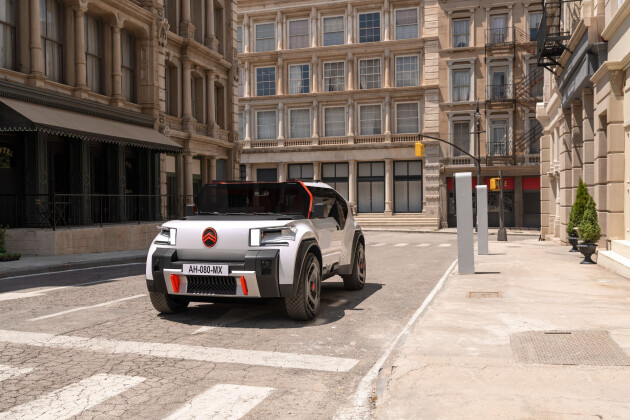 News
NewsThe Citroën Oli is an electric mini pick-up made from recycled materials
...but it remains a 'design study' for now
-
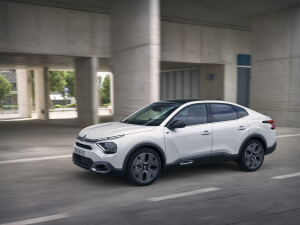 News
News2023 Citroën C4 X and electric e-C4 X revealed, Australian launch ruled out
The lifted crossover sedan unfortunately won't be heading Down Under
-
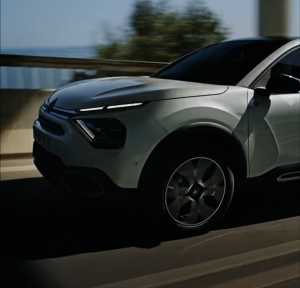 News
News2023 Citroën e-C4 X teased ahead of reveal
Citroën is set to reveal its latest crossover, with an all-electric variant spearheading the campaign
-
 News
News2022 Citroen C4 scores four stars in ANCAP crash test
C4 is one of just two cars to not take five stars since 2020
-

Citroen e-C4 under consideration for Australia
-
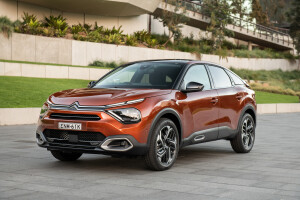
2022 Citroen C4 pricing and features for Australia
-
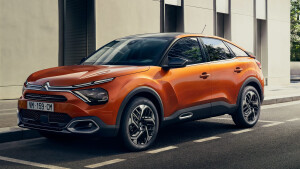
2022 Citroen C4 to arrive in Australia from November
-
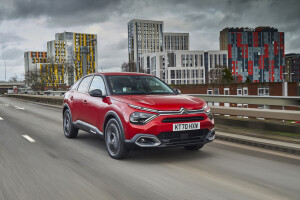
Citroen confirms late-2021 Australian arrival of new C4

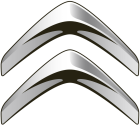
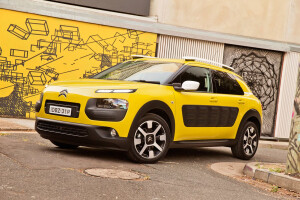
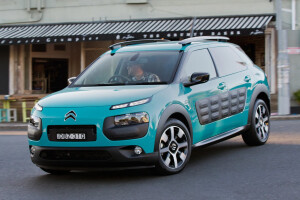
.jpg)
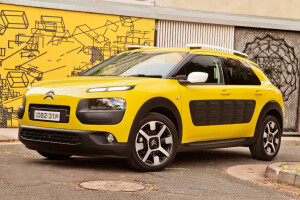
.jpg)
